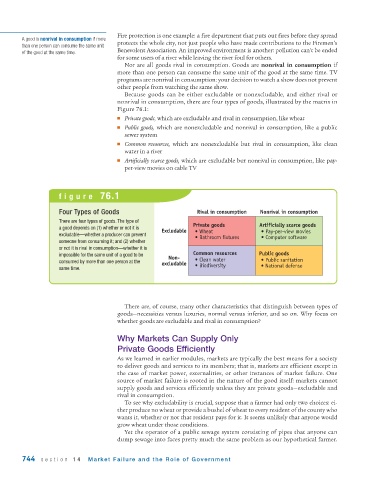Page 786 - Krugmans Economics for AP Text Book_Neat
P. 786
Fire protection is one example: a fire department that puts out fires before they spread
A good is nonrival in consumption if more
protects the whole city, not just people who have made contributions to the Firemen’s
than one person can consume the same unit
Benevolent Association. An improved environment is another: pollution can’t be ended
of the good at the same time.
for some users of a river while leaving the river foul for others.
Nor are all goods rival in consumption. Goods are nonrival in consumption if
more than one person can consume the same unit of the good at the same time. TV
programs are nonrival in consumption: your decision to watch a show does not prevent
other people from watching the same show.
Because goods can be either excludable or nonexcludable, and either rival or
nonrival in consumption, there are four types of goods, illustrated by the matrix in
Figure 76.1:
■ Private goods, which are excludable and rival in consumption, like wheat
■ Public goods, which are nonexcludable and nonrival in consumption, like a public
sewer system
■ Common resources, which are nonexcludable but rival in consumption, like clean
water in a river
■ Artificially scarce goods, which are excludable but nonrival in consumption, like pay-
per-view movies on cable TV
figure 76.1
Four Types of Goods Rival in consumption Nonrival in consumption
There are four types of goods. The type of
Private goods Artificially scarce goods
a good depends on (1) whether or not it is
Excludable • Wheat • Pay-per-view movies
excludable—whether a producer can prevent
• Bathroom fixtures • Computer software
someone from consuming it; and (2) whether
or not it is rival in consumption—whether it is
impossible for the same unit of a good to be Common resources Public goods
Non-
consumed by more than one person at the excludable • Clean water • Public sanitation
same time. • Biodiversity • National defense
There are, of course, many other characteristics that distinguish between types of
goods—necessities versus luxuries, normal versus inferior, and so on. Why focus on
whether goods are excludable and rival in consumption?
Why Markets Can Supply Only
Private Goods Efficiently
As we learned in earlier modules, markets are typically the best means for a society
to deliver goods and services to its members; that is, markets are efficient except in
the case of market power, externalities, or other instances of market failure. One
source of market failure is rooted in the nature of the good itself: markets cannot
supply goods and services efficiently unless they are private goods—excludable and
rival in consumption.
To see why excludability is crucial, suppose that a farmer had only two choices: ei-
ther produce no wheat or provide a bushel of wheat to every resident of the county who
wants it, whether or not that resident pays for it. It seems unlikely that anyone would
grow wheat under those conditions.
Yet the operator of a public sewage system consisting of pipes that anyone can
dump sewage into faces pretty much the same problem as our hypothetical farmer.
744 section 14 Market Failure and the Role of Gover nment

